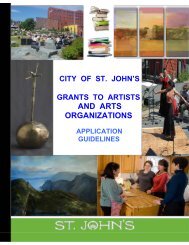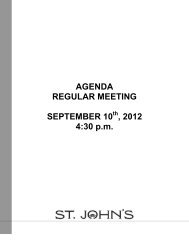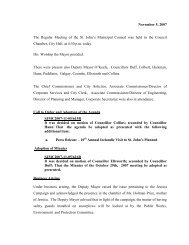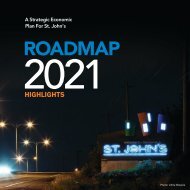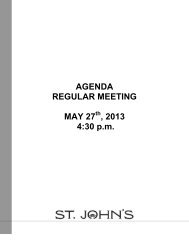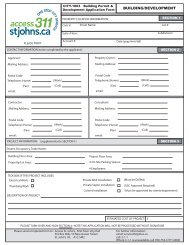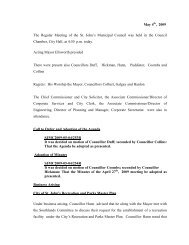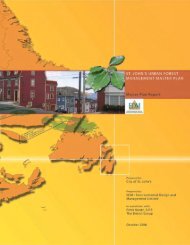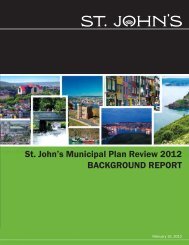Metrobus Transit Study.pdf - City of St. John's
Metrobus Transit Study.pdf - City of St. John's
Metrobus Transit Study.pdf - City of St. John's
Create successful ePaper yourself
Turn your PDF publications into a flip-book with our unique Google optimized e-Paper software.
<strong>St</strong>. John’s Transportation Commission (<strong>Metrobus</strong>) 2011<br />
Market Assessment and <strong>St</strong>rategic Directions <strong><strong>St</strong>udy</strong> – Part D: <strong>St</strong>rategic Directions<br />
reduces the overall cost effectiveness <strong>of</strong> the Zone Bus structure. Due to this inability to carry as<br />
many passengers per trip, a Zone bus becomes less cost effective than a fixed route service when a<br />
certain passenger volume is reached. At this point, a transit system typically switches to a fixed route<br />
system. This switch can also be seen negatively by many passengers that enjoy the convenience <strong>of</strong><br />
the zone bus service.<br />
Oakville <strong>Transit</strong> inaugurated a Zone bus system for low demand periods (evening and Sundays).<br />
The system used four vehicles for the Zone bus service, replacing eleven buses that were previously<br />
deployed on fixed routes in these <strong>of</strong>f-peak periods. Transfers were made at the GO <strong>Transit</strong> station,<br />
which facilitated transfers to interregional rail service to the <strong>City</strong> <strong>of</strong> Toronto. The new Zone bus<br />
Sunday service exceeded the previous ridership with seven fewer fixed route vehicles. The cost <strong>of</strong><br />
operating a zone bus service was about one third <strong>of</strong> the cost <strong>of</strong> operating a conventional fixed route<br />
service in the same area. However, as ridership grew due to the Zone bus success, the service was<br />
replaced with a fixed route service to accommodate growing demands.<br />
13.2 TransCab<br />
TransCab is also an effective service delivery model for low demand areas. TransCab involves an<br />
agreement between the transit operator and a local taxi company to pick up/drop <strong>of</strong>f passengers<br />
who are eligible for transit service. The taxi company receives the fare plus an additional payment<br />
from the transit company and this is usually significantly less expensive then dedicated conventional<br />
services operating a fixed route all day. For example if the taxi flat rate is $15.00 and the fare is<br />
$2.00, <strong>Metrobus</strong> would pay the taxi company $13.00 for the trip.<br />
The use <strong>of</strong> TransCab has been a common practice in the <strong>City</strong> <strong>of</strong> Hamilton for a number <strong>of</strong> years. In<br />
this case, the TransCab trip is made to the nearest bus stop and the duplicate ticket is taken as a<br />
transfer by the bus driver. No fare is collected on the way in, but a fare is collected on the way out.<br />
Although only one half <strong>of</strong> the fare is collected by the host municipality, it is viewed by Hamilton as a<br />
means <strong>of</strong> filling the bus which is on route in any event.<br />
The advantage <strong>of</strong> this model is that it provides an inexpensive way for <strong>Metrobus</strong> to provide service<br />
to a low demand area or period. For example, it costs <strong>Metrobus</strong> $98.56 per hour to operate service.<br />
In low demand peripheral areas such as the Goulds, TransCab service could be <strong>of</strong>fered during the<br />
<strong>of</strong>f peak periods (i.e. weekends and evenings) instead <strong>of</strong> regular fixed route service.<br />
If the uptake was infrequent and cost less than the hourly <strong>Metrobus</strong> rate 5 , it would be cost effective<br />
to provide a TransCab connecting to a transfer point at the Village Mall. It would also likely improve<br />
the level <strong>of</strong> service for passengers, as service would be more available than the hourly freqency that<br />
is currently provided. It may also increase ridership during the peak periods as the TransCab would<br />
<strong>of</strong>fer an additional level <strong>of</strong> flexibility and assurance that a service is available during the <strong>of</strong>f-peaks<br />
should the need to travel during this period arise.<br />
The challenge with TransCab is the difficutly implementing the service under the collective<br />
agreement with the driver’s union. Many system’s use this type <strong>of</strong> service delivery model as a<br />
method to build ridership in low demand areas. If a clear service standard is established that guides<br />
the introduction <strong>of</strong> new service, TransCab can be used when ridership falls below the standard as a<br />
5 For example, if a taxi fare cost $20.00 from the Goulds to the Village Mall and it could make four trips in one hour, the<br />
cost for <strong>Metrobus</strong> would be $80.00 minus fares collected.<br />
Dillon Consulting Limited Page 83





